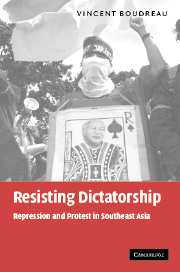Book contents
- Frontmatter
- Contents
- List of maps
- Acknowledgments
- List of abbreviations
- 1 Introduction
- 2 Protest, repression and transition in Southeast Asia
- 3 Authoritarian attack and dictatorial rise
- 4 Protest in socialist Burma
- 5 New Order repression and the Indonesian opposition
- 6 The Philippine new society and state repression
- 7 Repression and protest in comparative perspective
- 8 People power and insurgency in the Philippine transition
- 9 Protest and the underground in Burma
- 10 Indonesia's democracy protests
- 11 Democracy protest and state repression
- List of references
- Index
9 - Protest and the underground in Burma
Published online by Cambridge University Press: 15 December 2009
- Frontmatter
- Contents
- List of maps
- Acknowledgments
- List of abbreviations
- 1 Introduction
- 2 Protest, repression and transition in Southeast Asia
- 3 Authoritarian attack and dictatorial rise
- 4 Protest in socialist Burma
- 5 New Order repression and the Indonesian opposition
- 6 The Philippine new society and state repression
- 7 Repression and protest in comparative perspective
- 8 People power and insurgency in the Philippine transition
- 9 Protest and the underground in Burma
- 10 Indonesia's democracy protests
- 11 Democracy protest and state repression
- List of references
- Index
Summary
Several months after the September 1988 coup installed the military State Law and Order Restoration Committee (SLORC) in Burma, Intelligence Chief Khin Nyunt held a series of press conferences, largely in English for expatriate journalists and diplomats to set forth the regime's account of the 1988 democracy protests. The conferences seemed laughable and received substantial ridicule from anti-regime activists and foreign observers. One conference exposed a rightist conspiracy in which secret cells and subversive foreigners worked against the regime. The next unmasked a leftist underground conspiracy to overthrow the state. At each event, SLORC presented a lengthy narrative of the 1988 protests, augmented with biographical dossiers on key conspirators, in what seemed obvious and clumsy propaganda. That the press conferences occurred at all is notable, for Ne Win never cared much what the outside world (save immediate neighbors) thought. But few beyond the new government's thrall seemed even to consider the possibility that the state reports had any basis.
Neither, however, do alternative descriptions explain the events. Such accounts often attribute movement power to its leaders (like Nobel Laureate Aung San Suu Kyi and Generals Aung Gyi and Tin Oo), to widespread economic crisis and currency demonetization, to regime brutality, to foreign radio broadcasts and even to the auspiciousness of the August 8, 1988 (8–8–88) demonstration date. As a group, these positions share an important feature: they all argue that protest blossomed spontaneously from the righteous anger of a society pushed to the brink.
- Type
- Chapter
- Information
- Resisting DictatorshipRepression and Protest in Southeast Asia, pp. 190 - 214Publisher: Cambridge University PressPrint publication year: 2004



